Stiffness
17th January 2012In weather terms, 2012 started like a lion in some parts with Scotland getting a particular battering. Before that, the second day of the year saw me crossing hills to pop over to Buxton. That act planted in my mind the prospect of exploring more of Macclesfield’s hills this year. However, the following weekend was a quiet one for me.
The weather may have been offering in other places, but a prior commitment was the cause of my staying close to home and not getting out among hills in parts like Shropshire or even wandering along the streets of somewhere pleasing to the eye like Edinburgh or even Shrewsbury. That’s not to say that I wasn’t doing some more playing with ideas for outdoors outings, though.
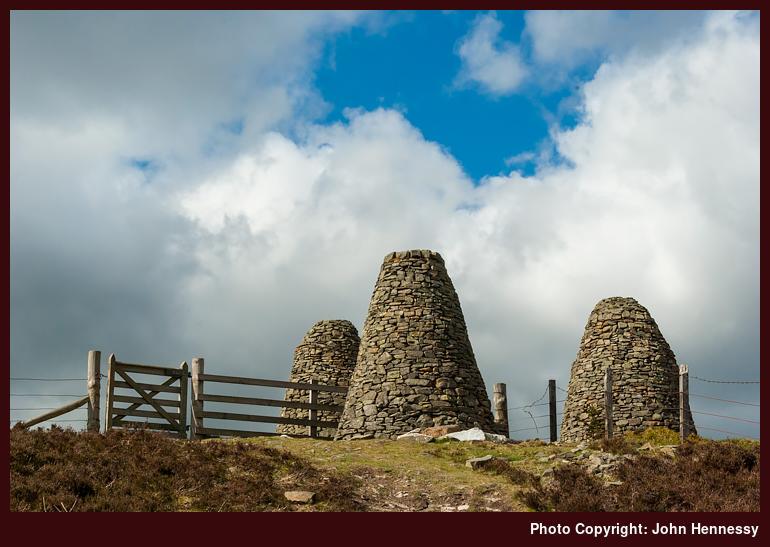
While adjusting albums in the photo gallery, thoughts were drawn to revisiting places where I haven’t been for a while. The online photo albums that attracted my attention were that for the Pennine Way and the Scottish Southern Uplands and Borders. The refresh involved adding photos were added, removing an old one rewriting a few descriptions. The trip ideas that came to mind while adjusting those photos included a stay in Peebles to explore the surrounding hills as well as getting to walk more of the Pennine Way or even the Southern Upland Way. Old and not so old photos act as reminders for me of past glories and lure me back to where I found them before.
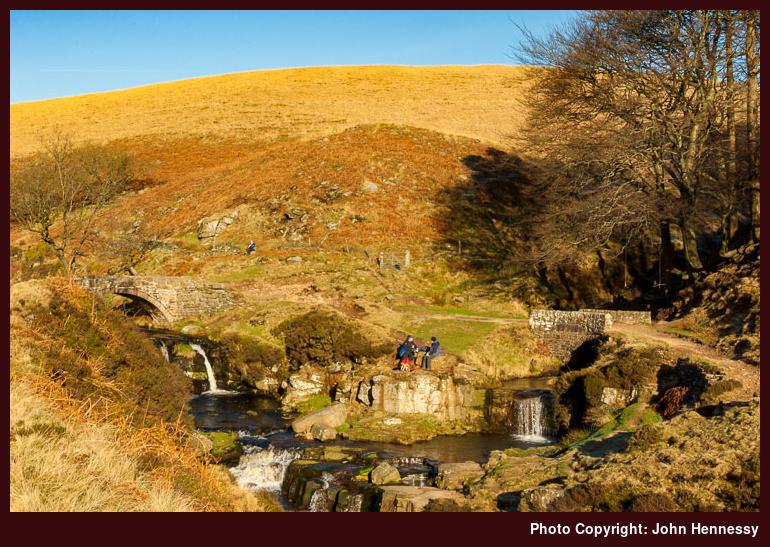
Last weekend’s cold frosty sunny weather was enough to draw out among hills again on Saturday. It was a day when any part of Britain’s hill country would have delighted and I did play with a walk around Sedbergh that involved an out and back yomp into and onto the Howgill Fells. Looking a bus timetables caused me to leave it for later in the year. Remembering how stiff I felt after a trot about Church Stretton’s hills before Christmas was a factor too in not deciding to not set my sights too high. Thus, I opted for a hike from the Cat and Fiddle Inn to Buxton that mainly followed the Dane Valley Way with a deliberate diversion or two. After all, the prospect of seeing the Three Shire Heads bridge in full winter lighting was too good to miss; it may have added to the distance covered but proved to be well worth that. If all goes to plan, more will be said about the walk sooner instead of later.
Though our settled spell of weather is leaving us at the time of writing, there are promising signs for the coming weekend too. While my limbs were stiff on Sunday and Monday, I take that as a cue for trying to get out a little more often than last year and January 2012 isn’t over yet. What I am not planning is anything as frenetic as this month last year when I walked successively in Wales, Scotland and Ireland. Pacing oneself is no bad thing either and quiet moments are needed for collating more ideas too. A recent catch-up with an article from one of last year’s issues of TGO has me wanting to sit with it and pore over maps while ogling the contained photos of splendid Lake District hill country. Wandering needs forethought at times.
A look back at 2011
26th December 2011For me, 2011 will have to be seen as one when work very much got in the way of hill wandering. Even if it did, I did get out on quite a few excursions over its course and some of them took me places where I hadn’t been before then. Also, there was a sense of unfinished business with a few of them and that always produces ideas for new trips into the outdoors.
January
January started out well with a few trips away. The first was to Wales when I walked from Roman Bridge station on the Conwy Valley railway line to Pen y Pass. A grey start became a glorious afternoon and repaid the nuisance of going through a forestry plantation where the right of way felt unwanted. Slipping on a branch into the wet didn’t help either but it soon forgotten with the pleasure granted soon afterwards. Sometimes, it is worth overcoming any ardour.
The January trip took me north to Fort William. This time, sunshine was in short supply and Fort William was so foggy that anyone would need to ask themselves why they had travelled overnight to get there as I did. Crewe was very foggy when I left it too so this was a general feature and not just a local Scottish one. Nevertheless, a trot down the banks of Loch Shiel was not fogbound and I was pencilling in plans for a return that have yet to be fulfilled. Glenfinnan saw a little sun too though it didn’t last but thoughts of explorations on a longer evening beguile. There’s thoughts of a shorter stroll around Cow Hill near Fort William that too could act as a lure yet.
The last weekend in January saw me use up a ferry booking that was a contingency for getting to Ireland during the pre-Christmas freeze of 2010 but got deferred so as to allow its cancellation and refund. That latter intention got set aside and I got to have an enjoyable yomp around Howth Head near Dublin. There again was a quota in operation regarding the amount of sunshine but I got enough for photos of Ireland’s Eye and Lambay Island. It would have been nice to have kept it for rounding the headland itself but there was no detraction from my enjoyment apart from the need to return under cover street lights before it became too dark. Finding such a quiet haven so near Dublin was a pleasure and looking across Dublin drew my eyes to the Dublin and Wicklow Mountains. From a previous escapade, I could pick out Great Sugarloaf near Kilmacanogue in County Wicklow. Viewing twinkling street lights from a quiet corner was a contrasting experience too. It’s amazing what Dubliners have on their doorstep.
February & March
The only trip away during these was one that took me to Oxford at the start of February. That certainly wasn’t a waste of a good day and I might be tempted to return again. In fact, it has me wondering about more urban walking destinations now that I recall it. Cambridge certainly has come to mind but there’s more than those with more humble destinations like Shrewsbury, Oswestry, Lancaster and Carlisle all coming to mind briefly once in a while over the last few years.
April, May & June
In another year, the good weather in February and March would have drawn me out in the countryside on a few weekends but 2011 was to see the next chance taken to await the start of April when I walked from Bollington back home while taking in the Kerridge ridge and the White Nancy. It may have been local but became an escape into peace in its own right. It was a reminder that there are places on my doorstep that needed frequenting more often.
It was to take until latter half of the Easter weekend for there to be another trip away from home. Then, it was a return to Llangollen after a gap of a number of years and this was to be my first trip there that involved an overnight stay in the town too. The peace of Easter Sunday evening wasn’t lost on me though it meant leaving the crowds of Llangollen after me and a commotion of bleating to die down once a large party had passed a flock of ewes and lambs. The paths that I was walking were being retraced rather than being trodden anew but that did nothing to detract from the fact that the everyday hurly burly felt a world away. That there was no need to rush home was a blessing too. The next day saw me wandering through countryside where I hadn’t been before and part of the North Berwyn Way for part of my walk. Not planning to cover too much in the way of distance meant that it was an unhurried hike and they always are best. Those who hang around Llangollen without exploring the surrounding countryside really are missing out even if that leaves it quiet for those of us fancying an escape from the frenzy of our working lives.
The Mayday bank holiday weekend immediately followed Easter this year and was extended by a royal wedding too. That encouraged me to head to Cowal for the weekend and it was a worthwhile venture too with three walks on two days. The first took me by the shores of Loch Long and Loch Goil while en route from Ardentinny to Carrick Castle. That was followed by another on the same day: a section of the Cowal Way from the shore of Loch Goil to Strachur. It was all good quiet replenishing fare for the spirit and in a part of the world that must get overlooked a lot as well.
The weather in May wasn’t so encouraging and June was a busy month for me too though it too had its interludes of sunshine. One of those drew me out early one Sunday morning on a cycle from my home around by Pott Shrigley. A January encounter from a few years back had me wondering if some photography when the rhododendron bushes were in flower might be worthwhile. However, I hadn’t bargained on the obscuring power of trees when they are in leaf so I am not so sure about the results evening if the sun was in the right part of the sky. Maybe a trot to the top of nearby Nab Head might end up being more productive.
July
July saw a bumper crop of outings with the first taking me along sections of St. Cuthbert’s Way. That weekend started with a hike from Wooler to Kirk Yetholm whose length left me tired but with a feeling that I have made a real start on exploring the landscape though which I had passed. The next day saw me walk from St. Boswells to Melrose while taking in both Dryburgh Abbey and the Eildon Hills. Lastly, I got to spend a few hours around Melrose Abbey in the summer heat.
The Isle of Man was my next port of call with a walk along Raad ny Foillan from Port Erin to Port St. Mary and then to Castletown. Apart from single shower, I seemed to have managed to pick a single sunny day in the middle of an unsettled spell of weather. It was sunny weather too that drew me to castles and coastline about the Menai Strait. Apart from revisiting Caernarfon and its famous castle, there was Beaumaris Castle and a section of the Isle of Anglesey Coastal Path to be savoured too. That weekend finished with a sunny crossing over the Menai Bridge. It was a contrast to the damp weekend spent in Ireland that preceded it. The last weekend in July saw me pass through mid Wales on the way to Gower. Conditions may not have been perfect or photography either along the Heart of Wales railway or in Gower but these first tastes may be followed later with more.
Remainder of the Year
Autumn had its sunnier interludes too but a busy working life limited my use of them to local cycles. One Saturday, I headed to Hare Hill and Alderley Edge and that has put an afternoon walk between the two into my mind as a future possibility. Others were similar and there were midday walks during a stretch when I worked from home too.
A few days booked away from work in December offered their chances too. The possibilities lined up in form of excursions to Church Stretton, Abergavenny and even Edinburgh. In the event, only the first of these happened and it was a pleasurable outing too with sleet showers doing nothing to dispel any sense of reverie. The leftovers can do for other occasions so I need not be annoyed that they didn’t happen. It’s better not to be greedy.
Looking to 2012
Some years can be more predictable than others, especially when it comes to working lives. There were a few for me when they came close but unpredictability is back again for me. 2012 looks to be a largely open book after a busy 2011 and a 2010 of two halves. Life away from work always is unpredictable so there’s no point attempting to see around all the corners.
On the hill wandering front, there aren’t any big plans for me in 2012 although there is a good number of ideas that are available for turning into real escapades. A little is needed for making that happen and that perhaps is one of the main lessons of 2011. If you cannot plan for an excursion and be ready to get away, then it just won’t happen. A ready supply of ideas and a ready rucksack might turn those ideas into outings and confront any desire for torpor on the way out the door.
It would be a pity to see them go
14th December 2011A recent poke around the SYHA website revealed some sad news: hostel closures. In total, there have been 46 but 5 of them are facing closure. There’s Canisbay near John O’Groats in Caithness, Arden near Loch Lomond and three in the Scottish Borders. These are Broadmeadows, Kirk Yetholm and Melrose. The latter losses will leave the network looking very bare between Scotland’s central belt and its border with England.
A weekend in early July had me staying in both Kirk Yetholm and Melrose. Both seemed well used though neither was completely full. Both are near long distance trails so that should explain their locations. St. Cuthbert’s Way goes by both of these and that’s how I chose them as places to stay. Kirk Yetholm also is the northern end of the Pennine Way and both the Southern Upland Way and and the Borders Abbeys Way pass Melrose. That makes both of these a big loss for long distance walkers who now need to make alternative arrangements unless others take them over and run as independent or affiliate hostels. After all, Melrose also is useful for cyclists.
In the article on the SYHA website announcing the news, the reason given is one that will be eerily familiar to those who have witnessed YHA closure announcements. Yes, the cost of refurbishment has been mentioned in concert with the standards expected by hostellers these days. The upgrades to Oban and Lochranza are mentioned and I can vouch for the one on Arran being a good job. However, it sounds like it took a dedicated husband and wife team to make it happen.
The announcement has me pondering the future of youth hostel associations and it’s a line of thought that may spawn another entry on here regarding the subject yet. There are those who consider that youth hostels are on borrowed time. At Kirk Yetholm, I met a grandmother taking her grandchildren hostelling before she felt it was too late to do so. That Kirk Yetholm now is facing closure makes here views sound prophetic.
From Abbey to Abbey: St. Boswells to Melrose
12th December 2011Even without having walked from Wooler to Kirk Yetholm the day before, there would have been other reasons why following St. Cuthbert’s Way on foot all the way to Melrose wasn’t an option that I was considering when arising the next morning. Having only a day meant that covering the 36 miles was out of the question but my state of mind after the previous day’s walking meant I even questioned the sense even of covering just the last 7.5 miles of the trail north from St. Boswells. Fortunately, doing just that turned out to be the best decision for the glorious day that lay ahead of me.
Buses (there was a change in Kelso) got me from Kirk Yetholm to St. Boswells. One thing that was remiss of me was not to have a road map with me to show where I had got off the bus for the start of my walk. That bit of forethought would have saved me some bumbling before I got my bearings. Getting off a bus at a point other than where I expected has been known to throw me and this was one of those occasions.
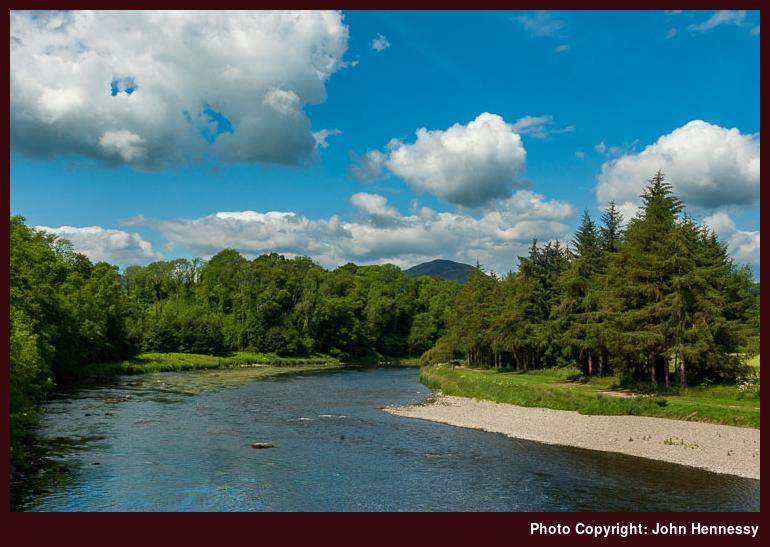
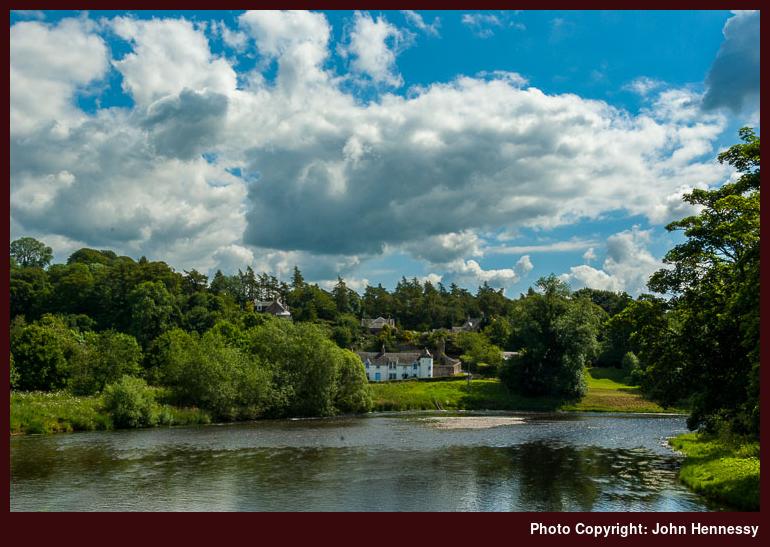
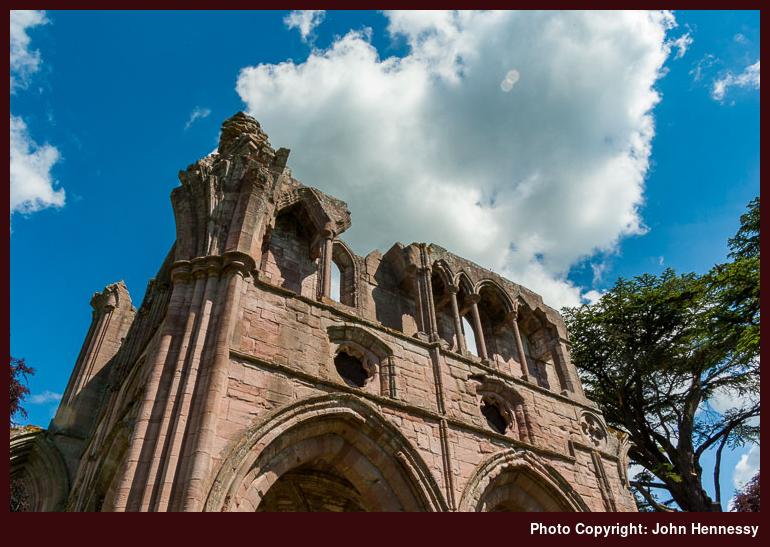
With the bumbling behind me, I was following the bank of the River Tweed after following a pleasant path from Lessudden House that really should be part of the trail instead of its taking you down a street instead. With navigational difficulties sorted, it was time to enjoy a morning stroll by a wide meandering river. Given the distance that lay ahead of me and the time that I had to cover it, there was no need to rush things and I was lured across a long footbridge to glimpse Dryburgh Abbey. In fact, this diversion was to cause me to pay to wander around the impressive ruins in the sunlight myself. Preparations for a wedding were ongoing but that did nothing to spoil things and I was away before the first attendees were going in anyway.
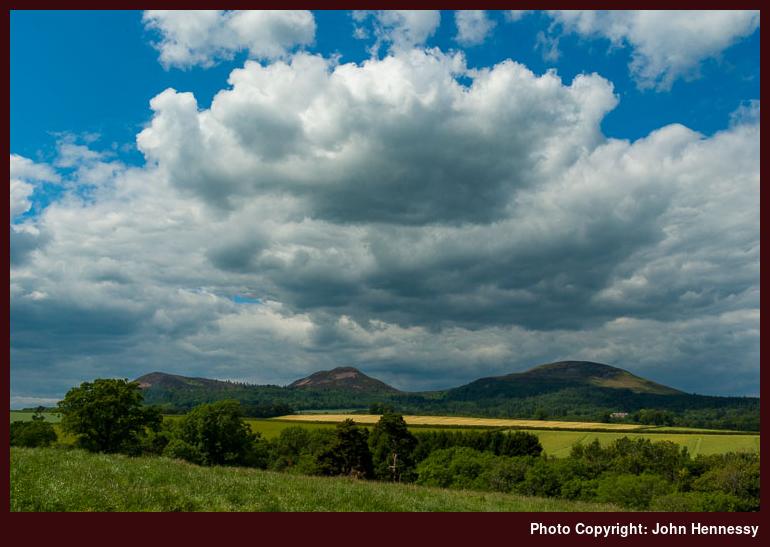
Another crossing of the Tweed returned me to my intended course as I pass through shading vegetation on the way to Newtown St. Boswells. Other than topping up on supplies, I wouldn’t have dallied there, especially in the gathering heat of the day. Road walking from there conveyed me to a much more forgiving track that fortunately was sheltered from the heat of the sun. There was more tarmac bashing before I reached Bowden, but cloud was gathering in the skies to cool the day for a little while.
That development turned out to be opportune because the next stage of my journey was going to take me up into the Eildon Hills. Before that, I found a useful seat by the side of the trail that allowed for a resting and refuelling stop. Civic-mindedness was apparent with a play area set up nearby though it wasn’t in use and a pathway had been made through the long grass too, so there could be no question about where to thread.
After passing a few fields and crossing Glenburnie Burn, it was into the tree cover of Greenside Plantation to the accompaniment of the sound of a forage harvester working in a nearby field. Rounding the lower slopes of Eildon Wester Hill took me into Broad Wood where the gradient really steepened. Nevertheless, it was nothing compared to those that I had scaled the day before and I left the trees after me to complete the ascent to Siller Stane and the saddle between Eildon Mid Hill and Eidon Hill North.
After another short stopover, I was lured up the steeper slopes of the Mid Hill to its top. The contours of the Wester Hill looked a lot flatter from up there and views of Melrose and its abbey were on offer too. As it happened, I didn’t linger long up there and was drawn to the Mid Hill after coming down again. Naturally, there was an ascent to reach the flat top of that too and I loitered there for a while to allow the cloud cover to break for some photos of a landscape that was reminiscent of Rothiemurchus in its own way if you cropped out the green agrarian lowlands that surrounded it.
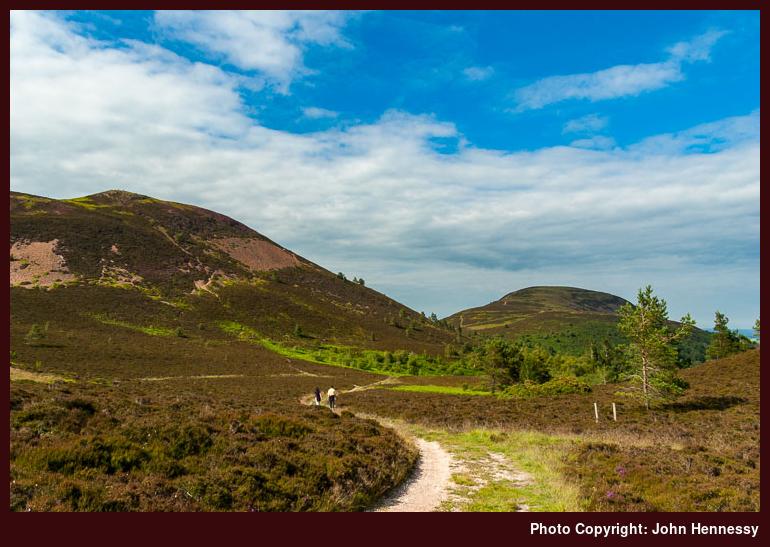
On retracing my steps from the Wester Hill, I decided to go up Eildon Hill North to finish off the job. There were far less folk about by this time and more dawdling followed. That seemed to be an ever present theme of this encounter with the Eildon Hills. In contrast to this stage of the evening before, being much nearer to my destination meant that there was no need to worry about the time of day at all. The fact that cloud still got in the way of the sun didn’t matter either as I started my descent to Melrose to claim my bed for the night.
The descent from the North Hill to reach St. Cuthbert’s Way was a carefree one and that theme continued even if it did come as a surprise to me how far around the North Hill the trail took me before dropping down through fields again. In May of last year, my designs on spending time among the Eildon Hills had to be set aside but not before popping up part of the way towards them. That point was reached again this time, having made much use of the postponed plans from that earlier time.
The official guide to St. Cuthbert’s Way states that Melrose is a place worthy of a little of your time. Having spent Saturday evening and much of the day after around there, I can vouch for that. In fact, Sunday came very warm so it was no day for walking despite all the long-distance trails that converge around Melrose. Apart from the Southern Upland Way, there also is the Borders Abbeys Way. In fact, it was too warm for walking even as far as the site of the old Roman fort of Trimontium near Newsteads and that of Old Melrose, where St. Cuthbert spent much of his life, is a little further again. That last though has me wondering if an extension of St. Cuthbert’s Way out to there wouldn’t be a bad idea though it would have to be an out and back trot.
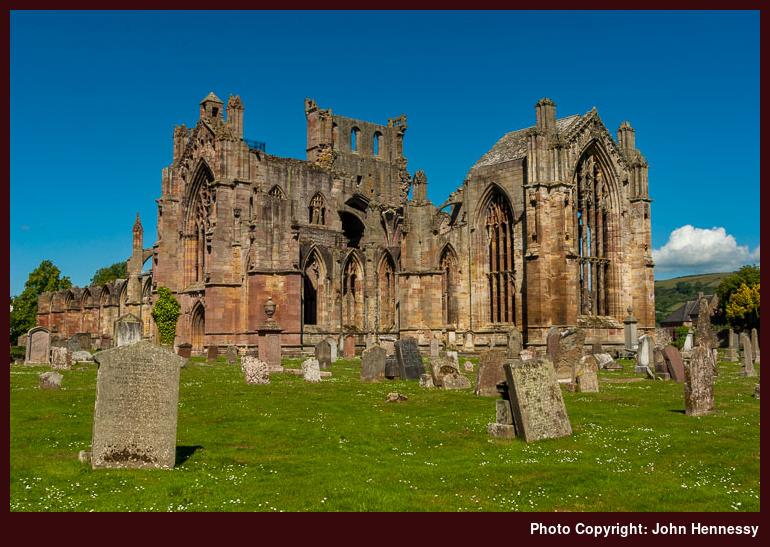
As it happened, I decided to explore the ruins of the Melrose Abbey that is best known and they are magnificent too. After seeing Dryburgh Abbey the day before, this was a variation on a theme and was equally unhurried. The coolness of the museum in the former Commendator’s House was a welcome respite from a day that became a scorcher. There were plenty of artefacts in there to keep me busy too and the way the door sounded when you opened and closed it was another reminder that it dated from another time. After all, it was older than the ideas that drew me to Northumberland and the Scottish Borders for a weekend of walking. Even then, the yearning for stillness and quiet could have been similar to those of the monks who found a monastery in the area all those centuries ago. Maybe some things just don’t change and returning to the hurly-burly of modern life to get home again was another of those.
Travel Arrangements
Bus service from 81 from Kirk Yetholm to Kelso and then bus service 67 from there to St. Boswell’s. Bus service 67 from Melrose to Berwick-upon-Tweed and train from there to Macclesfield with changes at York and Manchester.
A Border Crossing: Wooler to Kirk Yetholm
11th December 2011The prospect of having some time away from work at the start of July meant that I was playing with the prospect of using the time to head to Oban and reacquaint myself with some of the alluring countryside that surrounds the town. However, a change in circumstances was to rule out that escapade. With the reduction in time available to me, I decided on a weekend divided between Northumberland and the Scottish Borders instead. Though this might have been seen as a consolation prize, such was the quality of the countryside and the weather that such thoughts never entered my head. In fact, I seem to recall that I got better weather where I was, than I might have done in Argyll anyway.
Friday, the first one in July, saw me undertake a walk from Wooler to Kirk Yetholm with a night spent in the latter. That was followed by a shorter saunter on Saturday from St. Boswells to Melrose and chances to take in Dryburgh Abbey and the Eildon Hills weren’t passed up at all. Sunday became too hot for walking, but Melrose turned out to be a good place to spend some time, much of it admiring its abbey. Given the warmth, I set aside other thoughts such as venturing out to see the nearby Roman fort of Trimontium or Old Melrose, where the original abbey was situated, for another time. All in all, it was a glorious weekend spent in countryside familiar to St. Cuthbert, who gave his name to the long-distance trail that I used for much of my walking.
Somehow, a map can make a walk seem shorter than it is, and that statement could be applied to the thirteen miles between Wooler and Kirk Yetholm. Interestingly, the official guidebook to St. Cuthbert’s Way splits this in two with a break in Hethpool. Mind you, I still reckon that a full thirteen miles is a good use for a day out among hills even if my start was in the early afternoon and that was in spite of an early start from home.
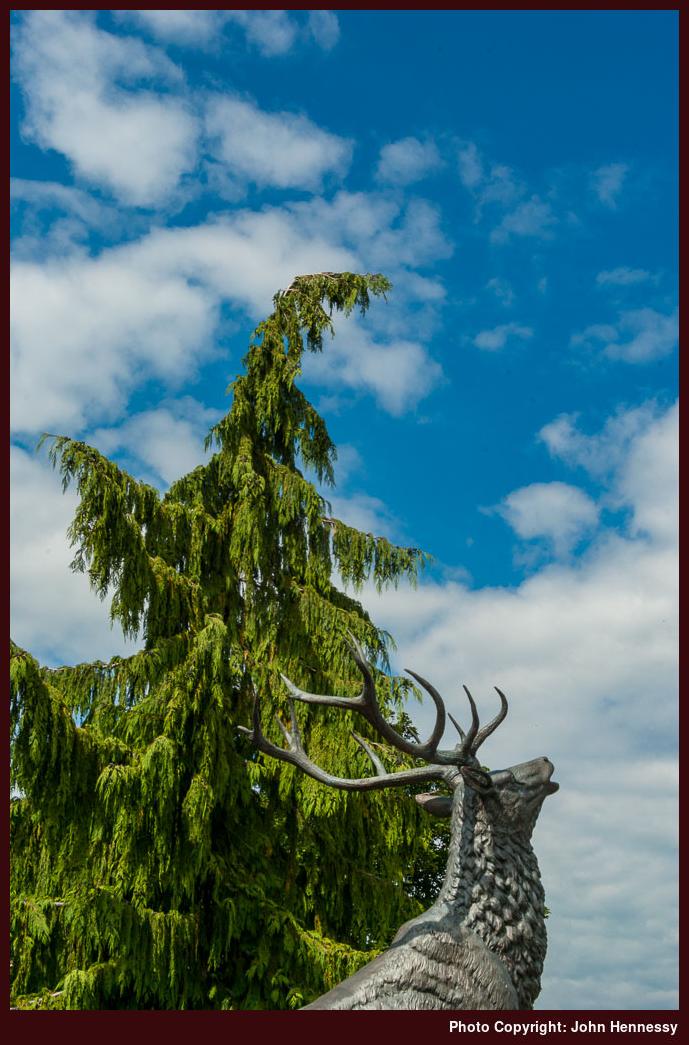
Knowing my way around the starting point meant that I needed not get too concerned when I unintentionally passed Wooler’s Catholic church. For a quicker approach from there, I stuck with what largely was a road walk to Humbleton. Though the skies were cloudy, the heat was building as I found on the track leading uphill from Humbleton. Up to that point, the only respite from tarmac had been a short public footpath that took me across a field. There was another compensation, however, in the form of a statue of a stag at the gate of Highburn House Country Holiday Park. It somehow was very reminiscent of the country towards which I was headed: Scotland.
Of course, there was a not inconsiderable amount of England to be walked first and I was feeling the heat as I shadowed the flank of Humbleton Hill. Rest stops allowed to look about me at the way that these hills were rising up from lowlands and at the line of the trail that I was going to join: St. Cuthbert’s Way. That came after an easing of the gradient and the passage from tended farmland into open moorland.
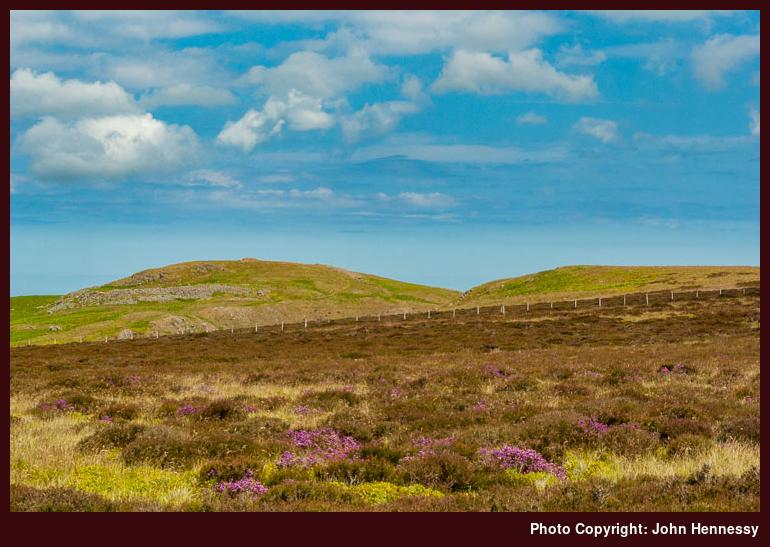
Vague memories can fool you and the direction that the trail didn’t feel right though it was entirely correct; it’s at times like these that a compass comes in very handy. Navigational doubts soon subsided with a clear path taking me across heather-clad moors with big skies opening out overhead. Not having to turn back at any point was a release for me and it was something in which I revelled as I passed Gains Law and Black Law. There was a lunch stop around here too.
Though hardly overrun, the countryside was being enjoyed by others too with greetings shared as we passed each other on our separate ways. The trail retained much of its height as it veered through higher country than the lower parts immediately surrounding Yeavering Bell. That height was set to be lost after passing Tom Talon’s Crag and any daydreams about calling to the top of Yeavering Bell were set aside. The consideration of dealing with an ascent after a descent helped to consign the possibility to my bank of excuses for a return. Given the distance that still lay ahead of me, it proved to be just as well.
After all the descent, some of it a steep, I was on a track leading to Kirknewton but continuing in the opposite direction towards Torleehouse. As it kept going beneath Newton Tors, the track became a path and it now was late afternoon. The countryside was tranquil as I travelled along the valley floor travel with encounters with tree cover contrasting with those heather-carpeted moors that I crossed earlier.
After crossing fields and passage through a wood, I found myself on tarmac again at Hethpool and also keeping an eye on the time of day. Early anxieties about not making as much progress as I might have liked were replaced with satisfaction in having got as far as I did. Hethpool may be like many places in these pretty parts, a mere collection of houses, but it was a good place to assess how long I had left to walk. As I did so, I wasn’t alone because folk were changing footwear at their cars, no doubt after a walk and who could blame them for that. In fact, I am tempted to return to savour more around there myself.
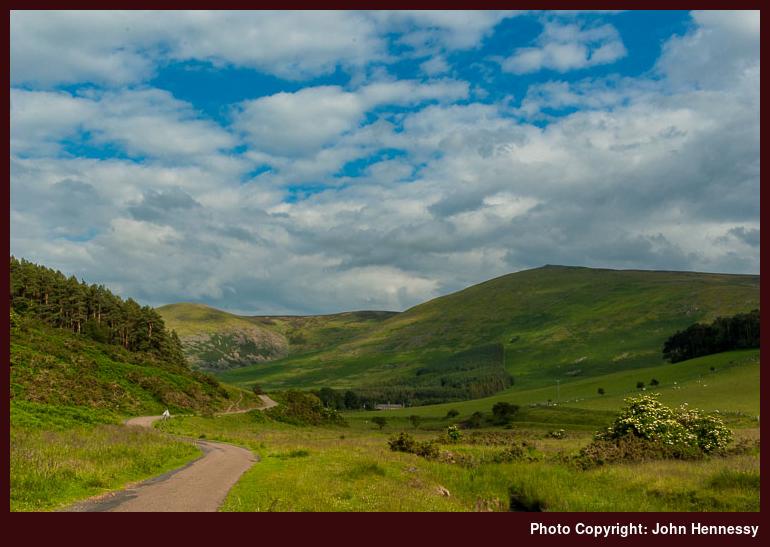
Tarmac was to take me all the way to Elsdonburn, first on a public road and then on a farm one. Seeing the way that I was covering ground along these was yet more encouragement and there was some scenery around me to enjoy too. The road to Trowupburn became another point to note how far lay ahead of me while also offering another excuse to return for future wanderings; this part of Northumberland is in no way short on possibilities. Planning would be needed due to the isolation, but isn’t it always thus?
A surprise was in store for me at Elsdonburn in the form of a flock of sheep blocking my way. Though I didn’t like disturbing the creatures, there was nothing for it but to stick to the right of way even if it caused a fair share of racket and I wasn’t far from a farmhouse. Thankfully, no cross words were said to me or no lectures on the inconvenience of obstructed rights of way needed in reply. Bringing rancour and confrontation is not why I got wandering though countryside so I continued on my way glad to be past that obstruction.
After that, there was the matter of crossing the border ridge with legs that already had carried me quite a way; the pace was going to be steady from here on to Kirk Yetholm. Careful attention was mandated until I reached Tupple’s Sike, the stream crossing preceding the last major ascent of the day. First, lush pasture was obscuring the line of the trail on Scaldhill Shank and I didn’t want to do any more trampling than was necessary. Then, there was a narrow path weaving a less than obvious line through the ensuing wood with waymarks on trees keeping me from straying.
Once beyond the wood, it was time to scale the steep slopes of Eccles Cairn after crossing of Tupple’s Sike. After the gradient eased, reaching the top of Eccles Cairn might have tempted me, but I decided against it in favour of passing the welcome sign marking the England-Scotland border; there may only have been ten metres of ascent needed but getting to Kirk Yetholm took greater priority. For all the effort expended in reaching it, the crossing into Scotland was a simple gateway in a wall.
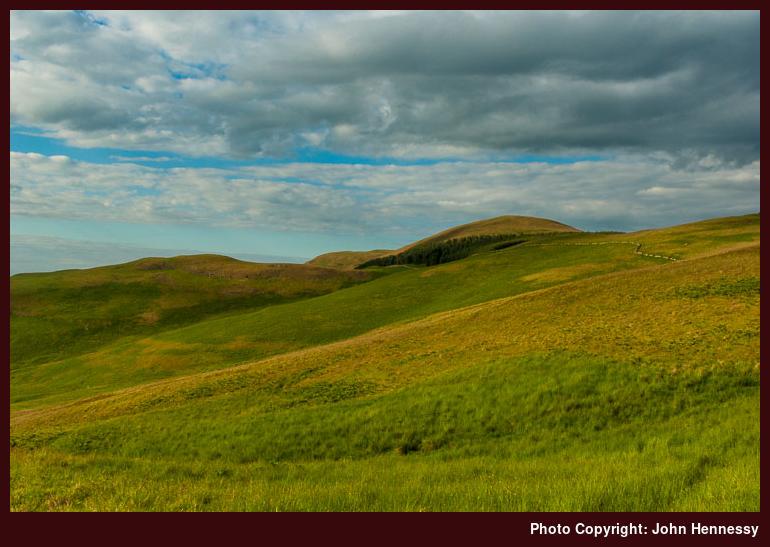
With a not so gradual descent down grass-carpeted slopes ahead of me, I took a little rest before setting off to join the Pennine Way; St. Cuthbert’s Way follows its course for the last stretch to Kirk Yetholm. With much of the height lost, Green Humbleton (a name that hearkened back to the start of the hike) was rounded with Sheilknowe Burn below the narrow path that now conveyed me. Crossing the burn got me to the car park where I stopped a while before crossing one last height of the day. Having a downhill stroll would have been my desire after the miles that I had walked the slopes that I had crossed but that hummock did make the world seem very away by the banks of the Sheilknowe Burn. Not much was stirring in Kirk Yetholm when I reached it so I headed towards my lodgings for the night. All that was on my mind was to rest after the miles travelled since leaving Wooler and more miles of walking were to follow the next day.
Travel Arrangements
Train journey from Macclesfield to Berwick-upon-Tweed with changes at Manchester and York. Bus service 464 from Berwick-upon-Tweed to Wooler.